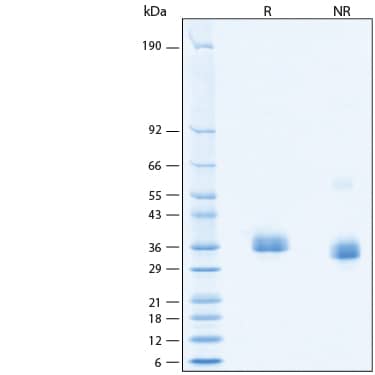Recombinant SARS-CoV-2 BA.4.6 Spike RBD His-tag Protein, CF
Recombinant SARS-CoV-2 BA.4.6 Spike RBD His-tag Protein, CF Summary
Product Specifications
Arg319-Phe541 (Gly339Asp, Arg346Thr, Ser371Phe, Ser373Pro, Ser375Phe, Thr376Ala, Asp405Asn, Arg408Ser, Lys417Asn, Asn440Lys, Leu452Arg, Ser477Asn, Thr478Lys, Glu484Ala, Phe486Val, Gln498Arg, Asn501Tyr, Tyr505His), with a C-terminal 6-His tag
Analysis
Product Datasheets
Carrier Free
CF stands for Carrier Free (CF). We typically add Bovine Serum Albumin (BSA) as a carrier protein to our recombinant proteins. Adding a carrier protein enhances protein stability, increases shelf-life, and allows the recombinant protein to be stored at a more dilute concentration. The carrier free version does not contain BSA.
In general, we advise purchasing the recombinant protein with BSA for use in cell or tissue culture, or as an ELISA standard. In contrast, the carrier free protein is recommended for applications, in which the presence of BSA could interfere.
11283-CV
| Formulation | Lyophilized from a 0.2 μm filtered solution in PBS with Trehalose. |
| Reconstitution | Reconstitute at 500 μg/mL in PBS. |
| Shipping | The product is shipped at ambient temperature. Upon receipt, store it immediately at the temperature recommended below. |
| Stability & Storage: | Use a manual defrost freezer and avoid repeated freeze-thaw cycles.
|
Scientific Data
 View Larger
View Larger
Recombinant SARS-CoV-2 BA.4.6 Spike RBD His-tag Protein (Catalog # 11283-CV) binds Recombinant Human ACE-2 Fc Chimera Protein (10544-ZN) in a functional ELISA.
 View Larger
View Larger
2 μg/lane of Recombinant SARS-CoV-2 BA.4.6 Spike RBD His-tag Protein (Catalog # 11283-CV) was resolved with SDS-PAGE under reducing (R) and non-reducing (NR) conditions and visualized by Coomassie® Blue staining, showing bands at 30-38 kDa.
Reconstitution Calculator
Background: Spike RBD
SARS-CoV-2, which causes the global pandemic coronavirus disease 2019 (Covid-19), belongs to a family of viruses known as coronaviruses that also include MERS-CoV and SARS-CoV-1. Coronaviruses are commonly comprised of four structural proteins: Spike protein (S), Envelope protein (E), Membrane protein (M) and Nucleocapsid protein (N) (1). The SARS-CoV-2 S protein is a glycoprotein that mediates membrane fusion and viral entry. The S protein is homotrimeric, with each ~180-kDa monomer consisting of two subunits, S1 and S2 (2). In SARS-CoV-2, as with most coronaviruses, proteolytic cleavage of the S protein into S1 and S2 subunits is required for activation. The S1 subunit is focused on attachment of the protein to the host receptor while the S2 subunit is involved with cell fusion (3-5). The S Protein of the SARS-CoV-2 virus, like the SARS-CoV-1 counterpart, binds a metallopeptidase, Angiotensin-Converting Enzyme 2 (ACE-2), but with much higher affinity and faster binding kinetics through the receptor binding domain (RBD) located in the C-terminal region of S1 subunit (6). It has been demonstrated that the S Protein can invade host cells through the CD147/EMMPRIN receptor and mediate membrane fusion (7, 8). Polyclonal antibodies to the RBD of the SARS-CoV-2 protein have been shown to inhibit interaction with the ACE-2 receptor, confirming RBD as an attractive target for vaccinations or antiviral therapy (9). There is also promising work showing that the RBD may be used to detect presence of neutralizing antibodies present in a patient's bloodstream, consistent with developed immunity after exposure to the SARS-CoV-2 (10). Based on amino acid (aa) sequence homology, the SARS-CoV-2 RBD has 73% identity with SARS-CoV-1 RBD, but only 22% homology with the MERS RBD. Several emerging SARS-CoV-2 genomes have been identified including the Omicron, or B.1.1.529, variant. First identified in November 2021 in South Africa, the Omicron variant quickly became the predominant SARS-CoV-2 variant and is considered a variant of concern (VOC). The Omicron variant contains 32 mutations in the S protein, 3 to 4 times more than in other SARS-CoV-2 variants, that potentially affect viral fitness and transmissibility (11). Of these mutations,15 are located in the RBD domain and allow the Omicron variant to bind ACE-2 with greater affinity and, potentially, increased transmissibility (11, 12). Several additional mutations throughout the S protein have been shown or are predicted to enhance spike cleavage and could aid transmission (13-15). The study of the Omicron variant's impact on immune escape and reduced neutralization activity to monoclonal antibodies along with an increased risk of reinfection, even among vaccinated individuals, remains ongoing (16). The BA.4.6 subvariant shows resistency to neutralization of several antibodies (17).
- Wu, F. et al. (2020) Nature 579:265.
- Tortorici, M.A. and D. Veesler (2019) Adv. Virus Res. 105:93.
- Bosch, B.J. et al. (2003) J. Virol. 77:8801.
- Belouzard, S. et al. (2009) Proc. Natl. Acad. Sci. 106:5871.
- Millet, J.K. and G.R. Whittaker (2015) Virus Res. 202:120.
- Ortega, J.T. et al. (2020) EXCLI J. 19:410.
- Wang, K. et al. (2020) bioRxiv https://www.biorxiv.org/content/10.1101/2020.03.14.988345v1.
- Isabel, S. et al. (2020) Sci Rep. 10, 14031. https://doi.org/10.1038/s41598-020-70827-z.
- Tai, W. et al. (2020) Cell. Mol. Immunol. 17:613.
- Okba, N. M. A. et al. (2020). Emerg. Infect. Dis. https://doi.org/10.3201/eid2607.200841.
- Shah, M. and Woo, H.G. (2021) bioRxiv https://doi.org/10.1101/2021.12.04.471200.
- Lupala, C.S. et al. (2021) bioRxiv https://doi.org/10.1101/2021.12.10.472102.
- Zhang, L. et al. (2020) Nat Commun. 11:6013.
- Lasek-Nesselquist, E. et al. (2021) medRxiv https://doi.org/10.1101/2021.03.10.21253285.
- Scheepers, C. et al. (2021) medRxiv https://doi.org/10.1101/2021.08.20.21262342.
- Callaway, E. and Ledford, H. (2021) Nature 600:197.
- Wang, Q. et al (2022) Lancet Infect. Dis https://doi.org/10.1016/S1473-3099(22)00694-6.
FAQs
No product specific FAQs exist for this product, however you may
View all Proteins and Enzyme FAQsReviews for Recombinant SARS-CoV-2 BA.4.6 Spike RBD His-tag Protein, CF
There are currently no reviews for this product. Be the first to review Recombinant SARS-CoV-2 BA.4.6 Spike RBD His-tag Protein, CF and earn rewards!
Have you used Recombinant SARS-CoV-2 BA.4.6 Spike RBD His-tag Protein, CF?
Submit a review and receive an Amazon gift card.
$25/€18/£15/$25CAN/¥75 Yuan/¥2500 Yen for a review with an image
$10/€7/£6/$10 CAD/¥70 Yuan/¥1110 Yen for a review without an image
